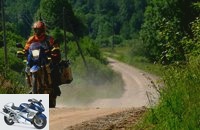Menus
Short test Kawasaki GPZ 1100 ABS
And yet it turns
Standing still means going backwards – especially with the front wheel. That is why Kawasaki focuses on progress, on ABS.
Whether it’s the daily news report, the centenary calendar or old farmer’s rules – nobody can predict the next onset of winter as precisely as MOTORRAD thanks to the GPZ rule, which reads: As soon as a GPZ 1100 rolls into the underground car park of the editorial house, the temperatures drop below freezing point and it starts to snow. The cause of this puzzling phenomenon could not be investigated in detail in the short time – the GPZ 1100 was only presented at the end of 1994. What is certain, however, is that the rule also applies to the new, black special model with ABS.
For the plus in driving safety, the buyer has to cope with an additional minus of 1500 marks in his wallet. If you also value storage space, you should also factor in a case system, because the formerly spacious storage compartment under the bench fell victim to the ABS hydraulic unit. The GPZ 1100 gained ten official and twelve weighed kilograms thanks to the ABS. So that these are not lost when the vehicle is loaded, the gross vehicle weight has been increased by ten kilograms compared to the standard version.
Buy complete article

Short test Kawasaki GPZ 1100 ABS
And yet it turns
For Kawasaki Germany, the tests of the standard version in 1995 were a pre-production model, which also explains why this time – in contrast to the individual test (MOTORRAD 1/1995) – the fuel consumption gives no reason for criticism: the GPZ 1100 ABS burns just under six liters per 100 kilometers driven, and the KCAS secondary air system ensures that a large part of the pollutants that are generated are post-burned. This system is now being installed in all large-displacement Kawasaki models – an at least as valuable contribution to environmental protection as the new anti-lock braking system for active driving safety.
Only the anti-lock braking system is offered exclusively for the GPZ 1100 ABS. Such anti-lock protection when braking pays off particularly when the coefficient of friction between the tires and the road surface is difficult to assess, for example in wet conditions, on changing road surfaces or in cold weather, when the tires barely reach operating temperature. The conditions were ideal for the first functional test: after all the brake levers had been pulled and pressed with all their might, the pads bite hard in the usual Kawasaki manner. A fraction of a second later, the ABS takes over and initially significantly reduces the brake pressure in the brake calipers, while the fork rebounds a good bit. It takes a while – in a dangerous situation it must appear as if hours have passed – until the ABS has approached the optimum deceleration again, while the hand and foot brake levers pump up and down vigorously. If the road surface changes, this game repeats itself again due to the jump in the coefficient of friction until the Kawasaki comes to a standstill safely and without blocking.
Under optimal external conditions, an experienced motorcyclist without ABS will certainly be faster, at least if he has enough time to prepare for the braking maneuver. But emergency situations arise completely unexpectedly in public road traffic, and then there is usually a puddle or gravel on the road – how good, if you then have a GPZ 1100 with ABS.
Related articles
-
Endurance test Kawasaki ER-5 Twister
Endurance test Kawasaki ER-5 Twister Number-5 is alive Small, simple motorcycles tend to have long and exhausting lives. The long-distance test ER-5 is…
-
Endurance test final balance of the Kawasaki ZX-10R
Bilski Endurance test final balance of the Kawasaki ZX-10R Too good to be stripped After 50,000 kilometers, the door is opened, looked inside and…
-
Gargolov Top test Kawasaki ZZ-R 1200 Heavy hum A sports tourer, mighty, strong, carved from the solid: the Kawasaki ZZ-R 1200. By no means perfect, but…
-
Kawasaki Z 900 RS (2018) in the test
Jacek Bilski 23 photos bilski-fotografie.de 1/23 Kawasaki Z 900 RS: technology from the Z 900, style based on the epoch-making Z1. bilski-fotografie.de…
-
Comparison test: BMW K 1300 GT, Kawasaki 1400 GTR, Yamaha FJR 1300 A
Gargolov Comparison test: BMW K 1300 GT, Kawasaki 1400 GTR, Yamaha FJR 1300 A Great tourers in Corsica In the touring segment, there is hardly a way…
-
Comparison test Kawasaki Ninja 250 R- Yamaha WR 250 X
Jahn 9 photos Yamaha 1/9 Yamaha 2/9 Yamaha 3/9 Yamaha 4/9 Yamaha 5/9 Yamaha 6/9 Yamaha 7/9 Yamaha 8/9 Yamaha 9/9 Comparison test Kawasaki Ninja 250 R /…
-
Comparison test Honda CBR 1100 XX against Kawasaki ZZ-R 1100
Honda CBR 1100 XX Super Blackbird Comparison test, Honda CBR 1100 XX Blackbird, Kawasaki ZZ-R 1100 Honda CBR 1100 XX versus Kawasaki ZZ-R 1100 Away…
-
Comparison test BMW K 1200 RS against Honda CBR 1100 XX
Comparison test BMW K 1200 RS against Honda CBR 1100 XX Crown jewels K 1200 RS and CBR 1100 XX are the image carriers of BMW and Honda. You don’t just…
-
Gargolov Top test Kawasaki Z 750 In a class of its own Either no opponents or “a lot of enemy, a lot of honor”? In the past, Kawasaki’s Z 750 occupied…
-
Honda CB 1100 RS, Kawasaki Z 900 RS and Yamaha XSR 900 in the test
bilski-fotografie.de 31 photos bilski-fotografie.de 1/31 The Honda CB 1100 RS. bilski-fotografie.de 2/31 A feast for the eyes: Visually, the Honda is…